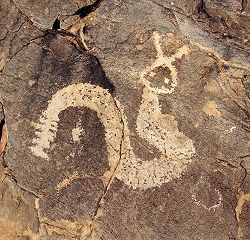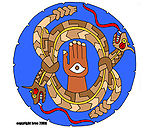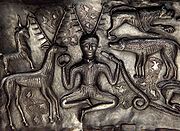
Sint Holo
Encyclopedia

Native Americans in the United States
Native Americans in the United States are the indigenous peoples in North America within the boundaries of the present-day continental United States, parts of Alaska, and the island state of Hawaii. They are composed of numerous, distinct tribes, states, and ethnic groups, many of which survive as...
. Details vary among tribes, with many of the stories associating the mystical figure with water, rain, lightning and/or thunder. Horned Serpents were major components of the Southeastern Ceremonial Complex
Southeastern Ceremonial Complex
The Southeastern Ceremonial Complex is the name given to the regional stylistic similarity of artifacts, iconography, ceremonies, and mythology of the Mississippian culture that coincided with their adoption of maize agriculture and chiefdom-level complex social organization from...
of North American prehistory.
Horned serpents also appear in European and Near Eastern mythology.
In Native American culture

Oral history
Oral history is the collection and study of historical information about individuals, families, important events, or everyday life using audiotapes, videotapes, or transcriptions of planned interviews...
of numerous Native American
Indigenous peoples of the Americas
The indigenous peoples of the Americas are the pre-Columbian inhabitants of North and South America, their descendants and other ethnic groups who are identified with those peoples. Indigenous peoples are known in Canada as Aboriginal peoples, and in the United States as Native Americans...
cultures, especially in the Southeastern Woodlands and Great Lakes
Great Lakes
The Great Lakes are a collection of freshwater lakes located in northeastern North America, on the Canada – United States border. Consisting of Lakes Superior, Michigan, Huron, Erie, and Ontario, they form the largest group of freshwater lakes on Earth by total surface, coming in second by volume...
.
Muscogee Creek traditions include a Horned Serpent and a Tie-Snake, estakwvnayv in the Muscogee Creek language. These are sometimes interpreted as being the same creature and sometimes different — similar, but the Horned Serpent is larger than the Tie-Snake. To the Muscogee people, the Horned Serpent is a type of underwater serpent covered with iridescent, crystalline scales and a single, large crystal in its forehead. Both the scales and crystals are prized for their powers of divination. The horns, called chitto gab-by, were used in medicine. Jackson Lewis, a Muscogee Creek informant to John R. Swanton
John R. Swanton
John Reed Swanton was an American anthropologist and linguist who worked with Native American peoples throughout the United States. Swanton achieved recognition in the fields of ethnology and ethnohistory...
, said, "This snake lives in the water has has horns like the stag. It is not a bad snake. ... It does not harm human beings but seems to have a magnetic power over game." In stories, the Horned Serpent enjoyed eating sumac, Rhus glabra
Rhus glabra
Rhus glabra is a species of sumac in the family Anacardiaceae, native to North America, from southern Quebec west to southern British Columbia in Canada, and south to northern Florida and Arizona in the United States and Tamaulipas in northeastern Mexico.One of the easiest shrubs to identify...
.
Alabama people call the Horned Serpent, tcinto såktco or "crawfish snake," which they divide into four classifications based on its horns' colors, which can be blue, red, white, or yellow.
Yuchi people made effigies of the Horned Serpent as recently as 1905. An effigy was fashioned from stuffed deerhide, painted blue, with the antlers painted yellow. The Yuchi Big Turtle Dance honors the Horned Serpent's spirit, which was related to storms, thunder, lighting, disease, and rainbows.
Among Cherokee people, a Horned Serpent is called an uktena. Anthropologist James Mooney
James Mooney
James Mooney was an American ethnographer who lived for several years among the Cherokee. He did major studies of Southeastern Indians, as well as those on the Great Plains...
, describes the creature:
Those who know say the Uktena is a great snake, as large around as a tree trunk, with horns on its head, and a bright blazing crest like a diamond on its forehead, and scales glowing like sparks of fire. It has rings or spots of color along its whole length, and can not be wounded except by shooting in the seventh spot from the head, because under this spot are its heart and its life. The blazing diamond is called Ulun'suti—"Transparent"—and he who can win it may become the greatest wonder worker of the tribe. But it is worth a man's life to attempt it, for whoever is seen by the Uktena is so dazed by the bright light that he runs toward the snake instead of trying to escape. As if this were not enough, the breath of the Uktena is so pestilential, that no living creature can survive should they inhale the tiniest bit of the foul air expelled by the Uktena. Even to see the Uktena asleep is death, not to the hunter himself, but to his family.

Sioux
The Sioux are Native American and First Nations people in North America. The term can refer to any ethnic group within the Great Sioux Nation or any of the nation's many language dialects...
belief, the Unktehila (Ųȟcéǧila) are dangerous reptilian water monsters that lived in anicent times. They were of various shapes. In the end the Thunderbirds
Thunderbird (mythology)
The Thunderbird is a legendary creature in certain North American indigenous peoples' history and culture. It is considered a "supernatural" bird of power and strength...
destroyed them, except for small species like snakes and lizards. This belief may have been inspired by finds of dinosaur
Dinosaur
Dinosaurs are a diverse group of animals of the clade and superorder Dinosauria. They were the dominant terrestrial vertebrates for over 160 million years, from the late Triassic period until the end of the Cretaceous , when the Cretaceous–Paleogene extinction event led to the extinction of...
fossils in Sioux tribal territory. The Thunderbird may have been inspired partly by finds of pterosaur
Pterosaur
Pterosaurs were flying reptiles of the clade or order Pterosauria. They existed from the late Triassic to the end of the Cretaceous Period . Pterosaurs are the earliest vertebrates known to have evolved powered flight...
skeletons.
Other known names
- Misi-kinepikw ("great snake")—CreeCree languageCree is an Algonquian language spoken by approximately 117,000 people across Canada, from the Northwest Territories and Alberta to Labrador, making it the aboriginal language with the highest number of speakers in Canada. It is also spoken in the U.S. state of Montana...
- Msi-kinepikwa ("great snake")—ShawneeShawnee languageThe Shawnee language is a Central Algonquian language spoken in parts of central and northeastern Oklahoma by only around 200 Shawnee, making it an endangered language. It was originally spoken in Ohio, West Virginia, Kentucky, and Pennsylvania...
- Misi-ginebig ("great snake")—Oji-CreeOji-Cree languageThe Severn Ojibwa or the Oji-Cree language is the indigenous name for a dialect of the Ojibwe language spoken in a series of Oji-Cree communities in northern Ontario and at Island Lake, Manitoba, Canada...
- Mishi-ginebig ("great snake")—OjibweOjibwe languageOjibwe , also called Anishinaabemowin, is an indigenous language of the Algonquian language family. Ojibwe is characterized by a series of dialects that have local names and frequently local writing systems...
- Pita-skog ("great snake")—AbenakiWestern Abnaki languageWestern Abnaki is one of the World's most endangered languages. In 1991 it was spoken by 20 individuals along the St. Lawrence River between Montreal and Quebec City, who lived mostly at Odanak, the site of the former mission village of St. Francis and about 50 individuals living throughout New...
- Sinti lapitta—ChoctawChoctaw languageThe Choctaw language, traditionally spoken by the Native American Choctaw people of the southeastern United States, is a member of the Muskogean family...
- Unktehi or Unktehila—DakotaDakota languageDakota is a Siouan language spoken by the Dakota people of the Sioux tribes. Dakota is closely related to and mutually intelligible with the Lakota language.-Dialects:...
In European iconography

Gundestrup cauldron
The Gundestrup cauldron is a richly-decorated silver vessel, thought to date to the 1st century BC, placing it into the late La Tène period. It was found in 1891 in a peat bog near the hamlet of Gundestrup, in the Aars parish in Himmerland, Denmark...
, and in Romano-Celtic Gaul was closely associated with the horned or antlered god Cernunnos
Cernunnos
Cernunnos is the conventional name given in Celtic studies to depictions of the horned god of Celtic polytheism. The name itself is only attested once, on the 1st-century Pillar of the Boatmen, but depictions of a horned or antlered figure, often seated in a "lotus position" and often associated...
, in whose company it is regularly depicted. This pairing is found as early as the fourth century BC in Northern Italy, where a huge antlered figure with torc
Torc
A torc, also spelled torq or torque, is a large, usually rigid, neck ring typically made from strands of metal twisted together. The great majority are open-ended at the front, although many seem designed for near-permanent wear and would have been difficult to remove. Smaller torcs worn around...
s and a serpent was carved on the rocks in Val Camonica
Val Camonica
Val Camonica is one of the largest valleys of the central Alps, in eastern Lombardy, about 90 km long. It starts from the Tonale Pass, at 1883 metres above sea level and ends at Corna Trentapassi, in the comune of Pisogne, near Lake Iseo...
.
A bronze image at Étang-sur-Arroux
Étang-sur-Arroux
Étang-sur-Arroux is a commune in the Saône-et-Loire department in the region of Bourgogne in eastern France.-References:*...
and a stone sculpture at Sommerécourt
Sommerécourt
Sommerécourt is a commune in the Haute-Marne department in north-eastern France.-See also:*Communes of the Haute-Marne department...
depict Cernunnos' body encircled by two horned snakes that feed from bowls of fruit and corn-mash in the god's lap. Also at Sommerécourt is a sculpture of a goddess holding a cornucopia and a pomegranate, with a horned serpent eating from a bowl of food. At Yzeures-sur-Creuse
Yzeures-sur-Creuse
Yzeures-sur-Creuse is a commune in the Indre-et-Loire department in central France.This is one of the oldest villages in Touraine, occupation dating back to the Upper Paleolithic era more than 10,000 years before Christ. During Ancient history and the Merovingian dynasty, it had an important...
a carved youth has a ram-horned snake twined around his legs, with its head at his stomach. At Cirencester
Cirencester
Cirencester is a market town in east Gloucestershire, England, 93 miles west northwest of London. Cirencester lies on the River Churn, a tributary of the River Thames, and is the largest town in the Cotswold District. It is the home of the Royal Agricultural College, the oldest agricultural...
, Gloucestershire, Cernunnos' legs are two snakes which rear up on each side of his head and are eating fruit or corn. According to Miranda Green, the snakes reflect the peaceful nature of the god, associated with nature and fruitfulness, and perhaps accentuate his association with regeneration.
Other deities occasionally accompanied by ram-horned serpents include "Celtic Mars", "Celtic Mercury", and the horned snake, and also conventional snakes, appears together with the solar wheel, apparently as attributes of the sun or sky god.
The description of Unktehi or Unktena is, however, more similar to that of a Lindorm in Northern Europe, especially in Southern Scandinavia, and most of all as described in folklore in Eastern Denmark (including the provinces lost to Sweden in 1658). There, too, it is a water creature of huge dimensions, while in Southern Sweden it is a huge snake, the sight of which was deadly. This latter characteristic is reminiscent of the basilisk
Basilisk
In European bestiaries and legends, a basilisk is a legendary reptile reputed to be king of serpents and said to have the power to cause death with a single glance...
.
In Mesopotamian iconography
In Mesopotamian mythology NingishzidaNingishzida
Ningishzida is a Mesopotamian deity of the underworld. His name in Sumerian is translated as "lord of the good tree" by Thorkild Jacobsen....
, a prototype of the Biblical serpent in the Garden of Eden, is sometimes depicted as a serpent with horns. In other depictions he is shown as human, but is accompanied by bashmu, horned serpents. Ningishzida shares the epithet Ushumgal, "great serpent", with several other Mesopotamian gods.
See also
- Avanyu
- Coi Coi-ViluCoi Coi-ViluCoi Coi-Vilu or Caicai-Vilu is the god of water and of all that inhabits it and is who rules the seas; according to Mapuche myths . This snake was a central figure in the Origin Of The Chiloean Archipelago...
- Chinese dragonChinese dragonChinese dragons are legendary creatures in Chinese mythology and folklore, with mythic counterparts among Japanese, Korean, Vietnamese, Bhutanese, Western and Turkic dragons. In Chinese art, dragons are typically portrayed as long, scaled, serpentine creatures with four legs...
- Feathered Serpent (deity)Feathered Serpent (deity)The Feathered Serpent was a prominent supernatural entity or deity, found in many Mesoamerican religions. It was called Quetzalcoatl among the Aztecs, Kukulkan among the Yucatec Maya, and Q'uq'umatz and Tohil among the K'iche' Maya...
- LindwormLindwormLindworm in British heraldry, is a technical term for a wingless bipedal dragon often with a venomous bite.-Etymology:In modern Scandinavian languages, the cognate lindorm can refer to any 'serpent' or monstrous...
- MoñáiMoñáiMoñái is the third son of Tau and Kerana and one of the seven legendary monsters of Guaraní mythology.This creature has an enormous serpent-like body was two straight, colorful horns which serve as antennas....
- QuetzalcoatlQuetzalcoatlQuetzalcoatl is a Mesoamerican deity whose name comes from the Nahuatl language and has the meaning of "feathered serpent". The worship of a feathered serpent deity is first documented in Teotihuacan in the first century BCE or first century CE...

